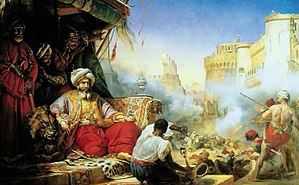This article includes a list of general references, but it lacks sufficient corresponding inline citations. (September 2021) |
| Muhammad Ali's rise to power | ||||||||
|---|---|---|---|---|---|---|---|---|
| Part of Ottoman wars in Africa | ||||||||
 The massacre of the Mamluks at Cairo, Egypt, painted by Horace Vernet | ||||||||
| ||||||||
| Belligerents | ||||||||
|
|
| Mamluks | ||||||
| Commanders and leaders | ||||||||
|
|
| Muhammad Alfi | ||||||
| Strength | ||||||||
| Unknown | 6,000 Albanian mercenaries[1] | Unknown | ||||||
| Casualties and losses | ||||||||
| Unknown | Unknown | 3,000 Turkish-Egyptian Mamluks[2] | ||||||
Muhammad Ali rose to power in Egypt following a long, three-way civil war between the Ottoman Empire, Egyptian Mamluks who had ruled Egypt for centuries, and Albanian mercenaries in the service of the Ottomans. The conflict ended in victory for the Albanians (from Rumelia) led by Ali.[3][4]
The three-way struggle occurred following the French invasion of Egypt by Napoleon. After the French were defeated, a power vacuum was created in Egypt. The Mamluks had governed Egypt before the French invasion and still retained power in the region. However, Egypt was officially a part of the Ottoman Empire and many Ottoman troops who had been sent to evict the French were still present.
- ^ Yapp, Malcolm (2014). The Making of the Modern Near East 1792-1923. A History of the Near East. Routledge. pp. 145–146. ISBN 9781317871071.
..., and the Albanian soldier named Muhammad 'Ali. Muhammad 'Ali (c. 1770-1849) had arrived in Egypt in 1801 as second-in-command of the Kavalla contingent of the 6,000 Albanian troops in the 10,000-strong Ottoman force sent to collaborate with the British forces against the French. In 1803 he became leader of the Albanian contingent, which was the most powerful military force in Egypt, and chief rival of the Ottoman pasha, whom he deposed in 1805 with the support of the ulema and people of Cairo.
- ^ "The Mamelukes are massacred in Egypt". www.historytoday.com. Retrieved 2022-08-19.
- ^ Kamusella, Tomasz (2023). "Central Europe's Limits in the North and the South". Acta Slavica Iaponica. 44. Slavic Research Center, Hokkaido University: 83–112. ISSN 0288-3503.
- ^ Cana, Frank Richardson (1911). . In Chisholm, Hugh (ed.). Encyclopædia Britannica. Vol. 9 (11th ed.). Cambridge University Press. pp. 106–113.
© MMXXIII Rich X Search. We shall prevail. All rights reserved. Rich X Search
